Non-Contact Measurement and Polarity Discrimination-Based Identification Method for Direct Lightning Strokes
Abstract
:1. Introduction
2. Configuration of the Non-Contact Lighting Monitoring System
2.1. Non-Contact Overvoltage Sensor
2.2. Tower Current Sensor
2.3. Field Installation
3. Feature Analysis of Different Lightning Stroke Types
3.1. Simulation Model of a 110 kV Transmission Line
3.2. Simulation for Lightning Strokes to the Top of the Tower
3.2.1. Lightning Strokes to the Top of the Reference Tower A
3.2.2. Lightning Strokes to the Top of Nearby Tower B or C
3.3. Simulation for Lightning Strokes to a Phase Conductor
3.3.1. Lightning Strokes to a Phase Conductor of the Reference Tower A
3.3.2. Lightning Strokes to the A Phase Conductor of Nearby Towers B or C
4. Feature Extraction and Identification of Lightning Stroke Types Based on the Polarity Discrimination Method
4.1. Feature Extraction and Identification of Lightning Stroke Types Based on Time-Domain Analysis
- (1)
- When lightning strokes to the top of the tower, Uins > 0 and Ig > 0; when lightning strokes to the phase conductor, Uins < 0 and Ig > 0.
- (2)
- When lightning strokes to the top of the reference tower with back flashover, the tower current has a negative polarity change; when lightning strokes to a phase conductor of the reference tower with flashover, the tower current has a positive polarity change.
- (3)
- When lightning strokes to the top of nearby tower, the Uins of the reference tower is positive before the insulator flashovers, whereas the Uins of the reference tower is negative after the insulator flashovers.
- (4)
- When lightning strokes to the top of reference tower, Uins = 0 when the insulator flashovers. When lightning strokes to the top of nearby tower with back flashover, the Uins of the reference tower becomes zero when the transient process ends.
4.2. Feature Extraction and Identification of Lightning Stroke Types Based on WTMM Analysis
- (1)
- When lightning strokes to the top of the reference tower with back flashover, lightning current discharges from the tower to the phase conductors, and the tower current sharply declines because of the shunting effect of the phase conductors (Figure 11a).
- (2)
- When lightning strokes to phase conductors of the reference tower with flashover, the lightning current discharges from the phase conductor to the tower, suddenly increasing the tower current, (Figure 11b).
5. Verification for Recognition
6. Conclusions
- (1)
- When lightning strokes to the top of the tower, Uins > 0 and Ig > 0; when lightning strokes to the phase conductor, Uins < 0 and Ig > 0.
- (2)
- When lightning strokes to the top of the reference tower with back flashover, the tower current has a negative polarity change; when lightning strokes to a phase conductor of the reference tower with flashover, the tower current has a positive polarity change.
- (3)
- When lightning strokes to the top of nearby tower, the Uins of the reference tower is positive before the insulator flashovers, whereas the Uins of the reference tower is negative after the insulator flashovers.
- (4)
- When lightning strokes to the top of reference tower, Uins = 0 when the insulator flashovers. When lightning strokes to the top of nearby tower with back flashover, the Uins of the reference tower becomes zero when the transient process ends.
Author Contributions
Funding
Conflicts of Interest
References
- Guido, A.; Salvatore, F.; Elisa, F.; Graziella, G.; Gaetano, Z. On the Distribution of Lightning Current among Interconnected Grounding Systems in Medium Voltage Grids. Energies 2018, 11, 771. [Google Scholar]
- Fabio, M.G.; Alberto, G.; Stefano, L.; Marco, M. Monte Carlo Evaluation of the Impact of Subsequent Strokes on Backflashover Rate. Energies 2016, 9, 139. [Google Scholar]
- Chen, J.; Zhu, M. Calculation of Lightning Flashover Rates of Overhead Distribution Lines Considering Direct and Indirect Strokes. IEEE Trans. Electromagn. Compat. 2014, 56, 668–674. [Google Scholar] [CrossRef]
- Takami, J.; Okabe, S. Observational Results of Lightning Current on Transmission Towers. IEEE Trans. Power Deliv. 2007, 22, 547–556. [Google Scholar] [CrossRef]
- Sima, W.; Lan, X.; Yang, Q.; Yuan, T. Statistical Analysis on Measured Lightning Overvoltage Surges in a 110 kV Air-insulated Substation. IET Sci. Meas. Technol. 2015, 9, 28–36. [Google Scholar] [CrossRef]
- Visacro, S.; Silveira, F.H. Lightning Performance of Transmission Lines: Methodology to Design Grounding Electrodes to Ensure an Expected Outage Rate. IEEE Trans. Power Deliv. 2015, 30, 237–245. [Google Scholar] [CrossRef]
- Nur, H.Z.; Mohd, Z.A.K.; Mohd, A.M.R.; Mahdi, I.; Norhafiz, A.; Nor, I.A.; Mohd, S.M.N. Lightning Surge Analysis on a Large Scale Grid-Connected Solar Photovoltaic System. Energies 2017, 10, 2149. [Google Scholar]
- Fang, Z.; Wang, B.; Lu, J.; Jiang, Z. Study on Impulse Breakdown Characteristics of Internal-Gap Lightning Protection Device Applied to 35 kV Distribution Line. Energies 2018, 11, 1758. [Google Scholar] [CrossRef]
- Shah, W.A.; He, H.; He, J.; Yang, Y. Continuous and Discontinuous Streamer Leader Propagation Phenomena under Slow Front Impulse Voltages in a 10-meter Rod-Plane Air Gap. Energies 2018, 11, 2636. [Google Scholar] [CrossRef]
- Zhang, L.; Fang, S.; Wang, G.; Zhao, T.; Zou, L. Studies on an Electromagnetic Transient Model of Offshore Wind Turbines and Lightning Transient Overvoltage Considering Lightning Channel Wave Impedance. Energies 2017, 10, 1995. [Google Scholar] [CrossRef]
- Zhou, W.J.; Wang, T.; Yu, J.H.; Zhang, S.F.; Cao, L.J. Study on Real-time Lightning Current Monitoring Sysmem for Overhead Wire. In Proceedings of the IEEE International Conference on High Voltage Engineering and Application (ICHVE), Chongqing, China, 9–12 November 2008; pp. 629–632. [Google Scholar]
- Takami, J.; Okabe, S. Characteristics of Direct Lightning Strokes to Phase Conductors of UHV Transmission Lines. IEEE Trans. Power Deliv. 2007, 22, 537–546. [Google Scholar] [CrossRef]
- Yang, Q.; Wang, J.; Sima, W.; Chen, L.; Yuan, T. Mixed Over-Voltage Decomposition Using Atomic Decompositions Based on a Damped Sinusoids Atom Dictionary. Energies 2011, 4, 1410–1427. [Google Scholar] [CrossRef] [Green Version]
- Wang, J.; Yang, Q.; Sima, W.; Yuan, T.; Zahn, M. A Smart Online Over-Voltage Monitoring and Identification System. Energies 2011, 4, 599–615. [Google Scholar] [CrossRef] [Green Version]
- Massarini, A.; Kazimierczuk, M.K. Self-capacitance of Inductors. IEEE Trans. Power Electron. 1997, 12, 671–676. [Google Scholar] [CrossRef]
- Jean, G.V.B. Electromagnetic Fields; New York Biswas Hope Press: New York, NY, USA, 2009. [Google Scholar]
- Sima, W.; Han, R.; Yang, Q.; Sun, S.; Liu, T. Dual LiNbO3 Crystal-Based Batteryless and Contactless Optical Transient Overvoltage Sensor for Overhead Transmission Line and Substation Applications. IEEE Trans. Ind. Electron. 2017, 64, 7323–7332. [Google Scholar] [CrossRef]
- Han, R.; Yang, Q.; Sima, W.X.; Zhang, Y.; Sun, S.P.; Liu, T.; Chen, S.Q. Non-contact measurement of lightning and switching transient overvoltage based on capacitive coupling and pockels effects. Electr. Power Syst. Res. 2015, 139, 93–100. [Google Scholar] [CrossRef]
- Chen, S.; Wang, H.; Du, L.; Li, J. Research on Characteristics of Noncontact Capacitive Voltage Divider Monitoring System Under AC and Lightning Overvoltages. IEEE Trans. Appl. Superconduct. 2014, 24, 1203–1205. [Google Scholar]
- Chen, S.; Wang, H.; Du, L.; Li, J. Research on a New Type of Overvoltages Monitoring Sensor and Decoupling Technology. IEEE Trans. Appl. Superconduct. 2014, 24, 1304–1307. [Google Scholar]
- Rakov, V.A.; Rachidi, F. Overview of Recent Progress in Lightning Research and Lightning Protection. IEEE Trans. Electromagn. Compat. 2009, 51, 428–442. [Google Scholar] [CrossRef] [Green Version]
- Yao, C.G.; Wu, H.; Mi, Y.; Ma, Y.; Shen, Y.; Wang, L. Finite Difference Time Domain Simulation of Lightning Transient Electromagnetic Fields on Transmission Lines. IEEE Trans. Dielectr. Electr. Insul. 2013, 20, 1239–1246. [Google Scholar]
- Wang, X.; Yu, Z.; He, J. Breakdown Process Experiments of 110- to 500-kV Insulator Strings under Short tail Lightning Impulse. IEEE Trans. Power Deliv. 2014, 29, 2394–2401. [Google Scholar] [CrossRef]
- Hara, T.; Yamamoto, O. Modeling of a Transmission Tower for Lightning Surge Analysis. IEE Proc. Gener. Trans Distrib. 1996, 143, 283–289. [Google Scholar] [CrossRef]
- Munukutla, K.; Vittal, V.; Heydt, G.T.; Chipman, D.; Keel, B. A Practical Evaluation of Surge Arrester Placement for Transmission Line Lightning Protection. IEEE Trans. Power Deliv. 2010, 25, 1742–1748. [Google Scholar] [CrossRef]
- Ametani, A.; Kawamura, T. A Method of a Lightning Surge Analysis Recommended in Japan Using EMTP. IEEE Trans. Power Deliv. 2005, 20, 867–875. [Google Scholar] [CrossRef]
- Gallagher, T.J.; Dudurych, I.M. Model of Corona for an EMTP Study of Surge Propagation along HV Transmission Lines. IEE Proc. Gener. Trans. Distrib. 2004, 151, 61–66. [Google Scholar] [CrossRef]
- Goran, J.; Juraj, H.; Tomislav, C.; Stjepan, S. Laboratory Test Bed for Analyzing Fault-Detection Reaction Times of Protection Relays in Different Substation Topologies. Energies 2018, 11, 2482. [Google Scholar]
- Nianqiang, L.; Ping, L. A Switching Method Based on FD and WTMM for ECG Signal Real-Time Feature Extraction. In Proceedings of the 2009 International Joint Conference on Computational Sciences and Optimization, Sanya, China, 24–26 April 2009; pp. 828–830. [Google Scholar]
- Wang, Z.; Chang, J.; Zhang, S.; Luo, S.; Jia, C.; Jiang, S.; Sun, B.; Liu, Y.; Liu, X.; Lv, G. An Improved Denoising Method in RDTS Based on Wavelet Transform Modulus Maxima. IEEE Sens. J. 2015, 15, 1061–1067. [Google Scholar] [CrossRef]

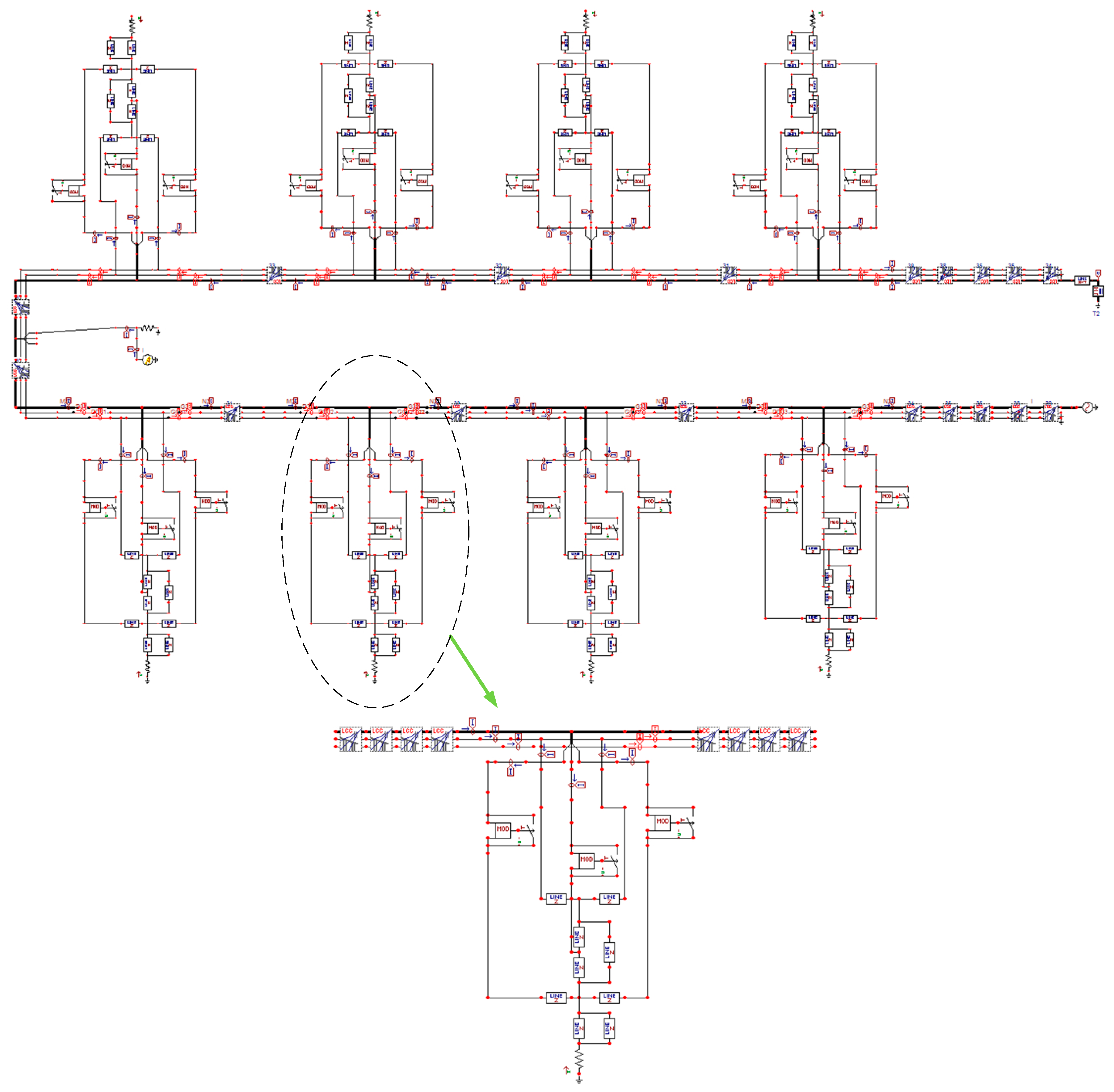
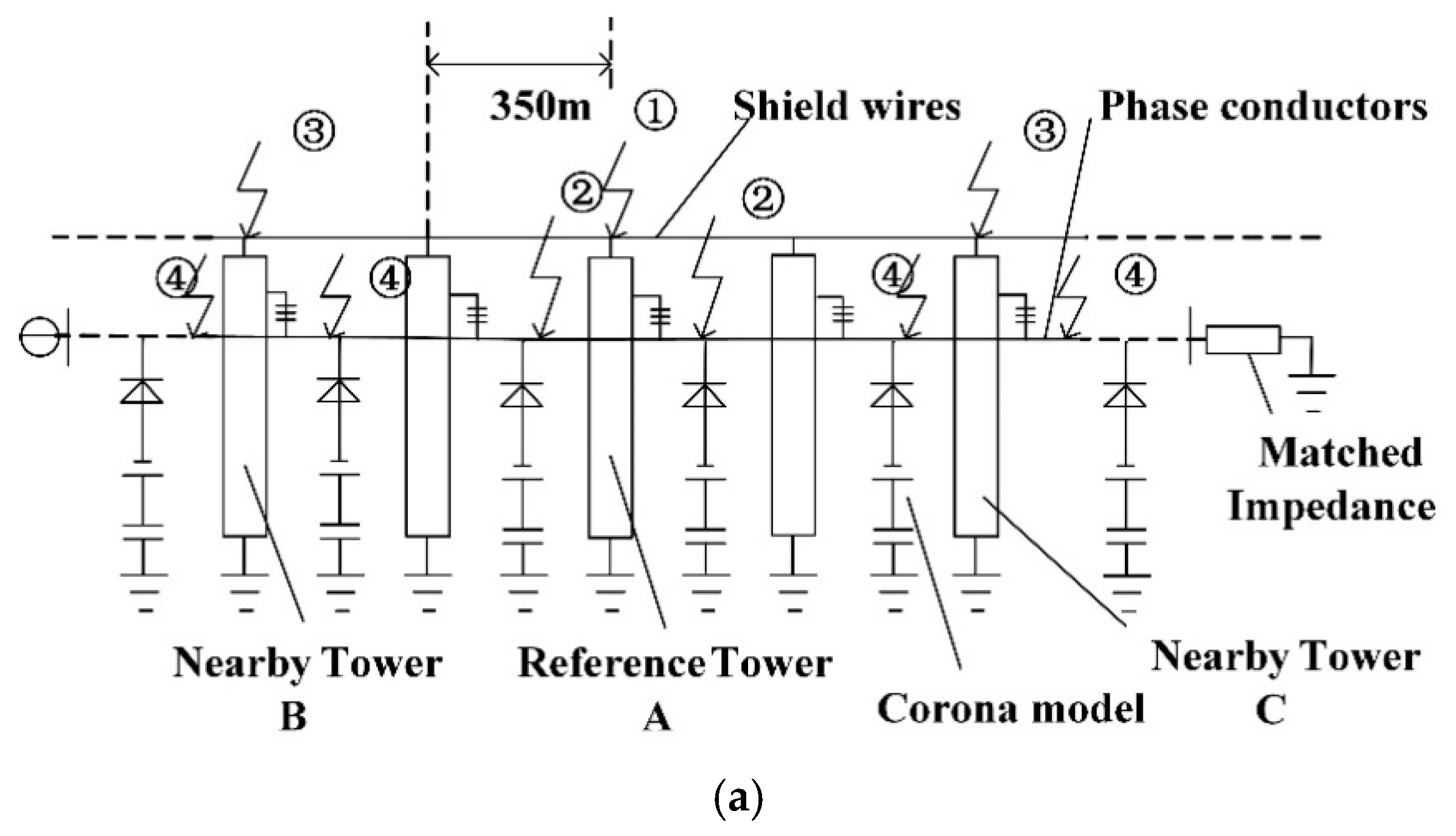
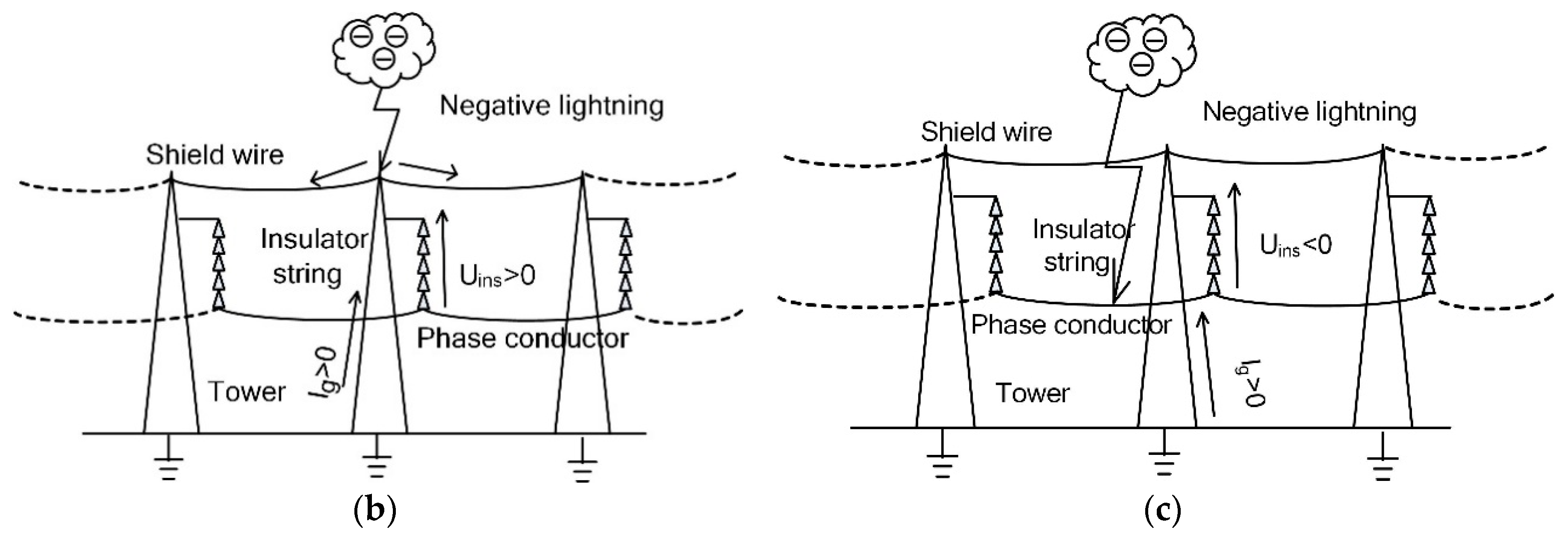
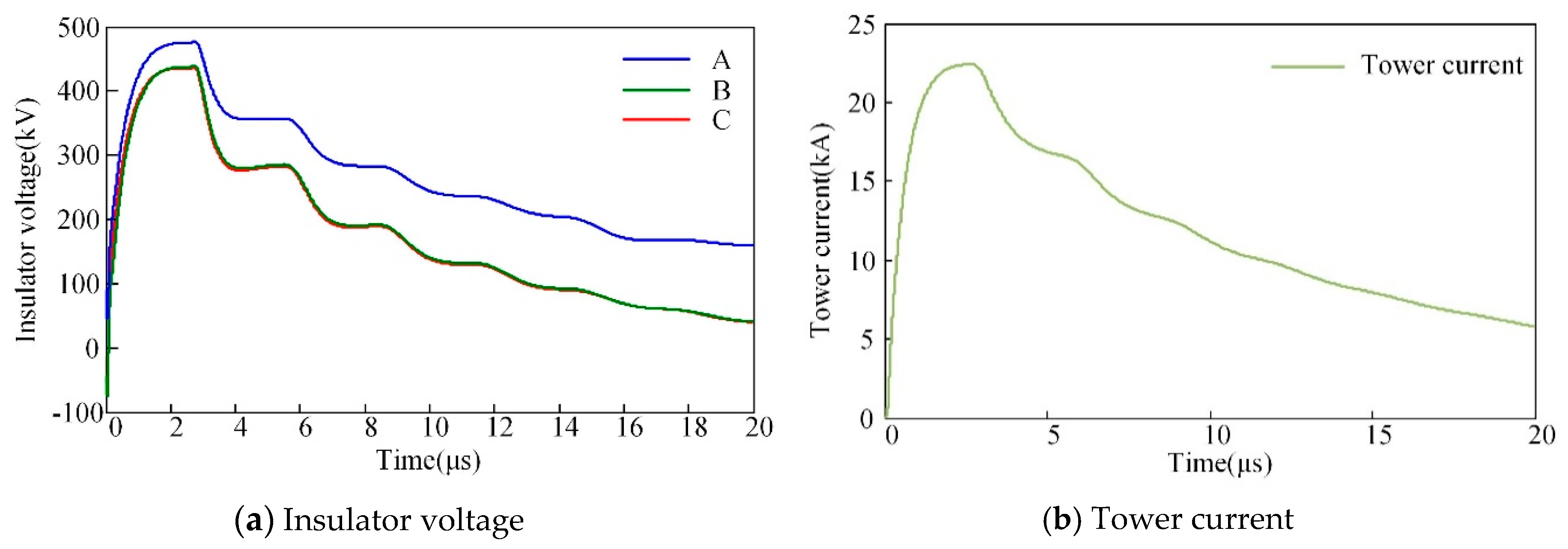

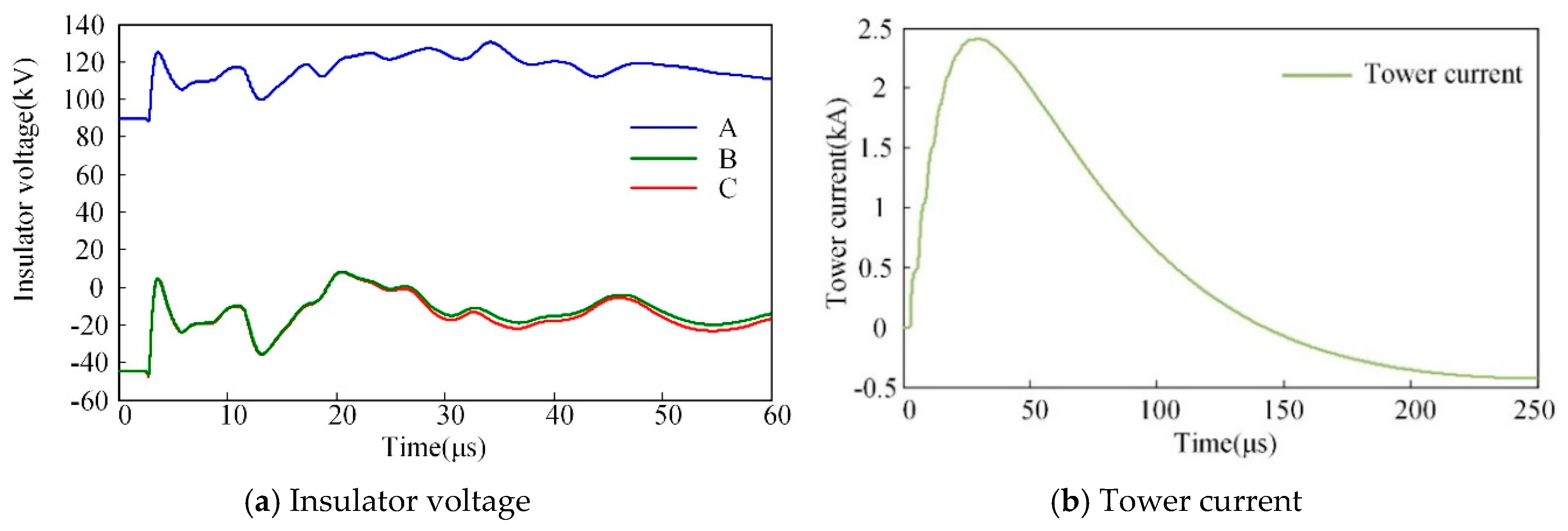
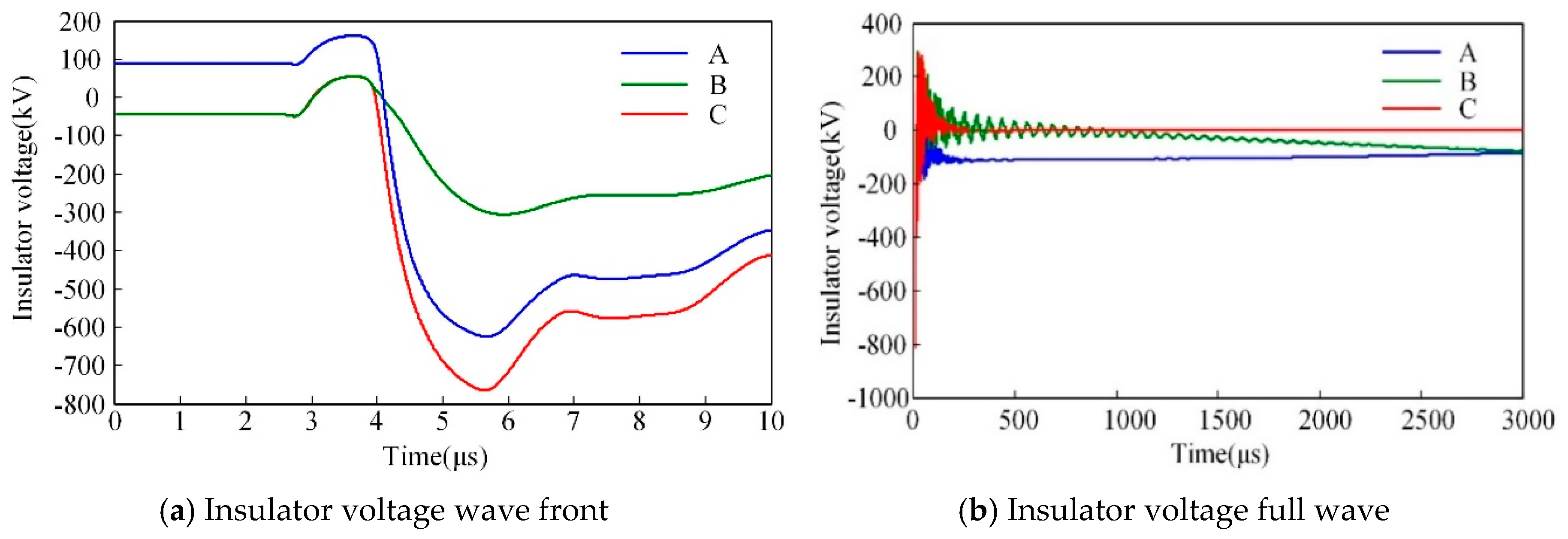
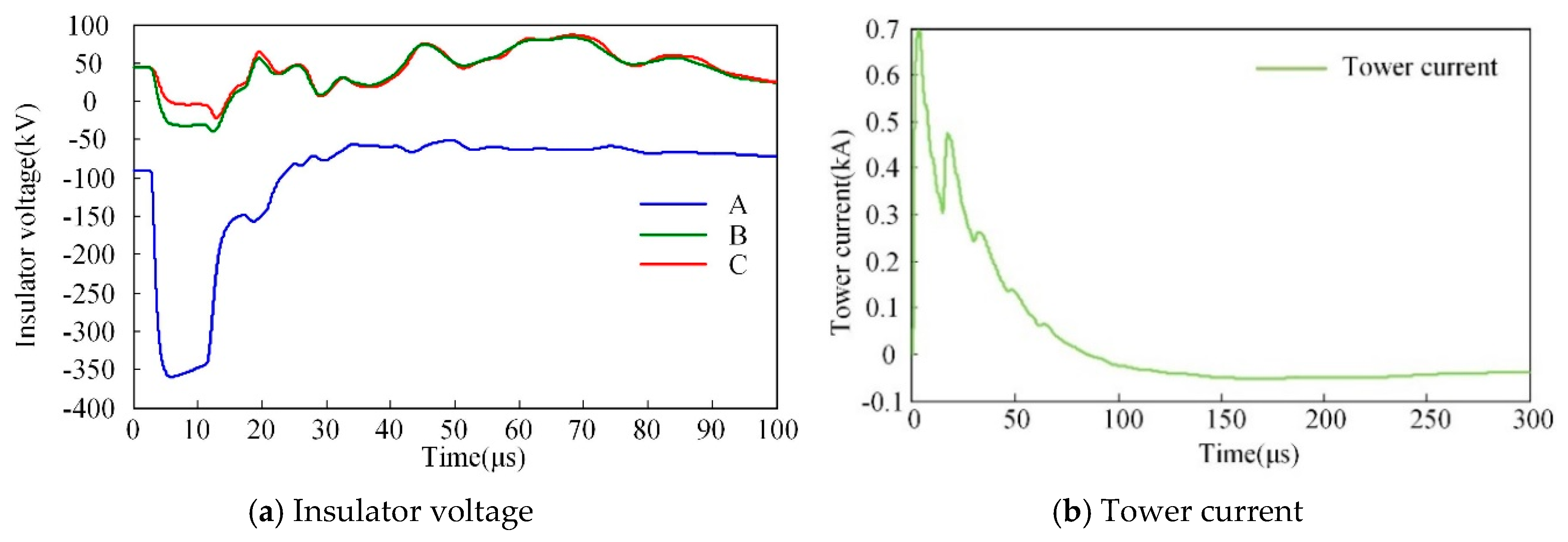

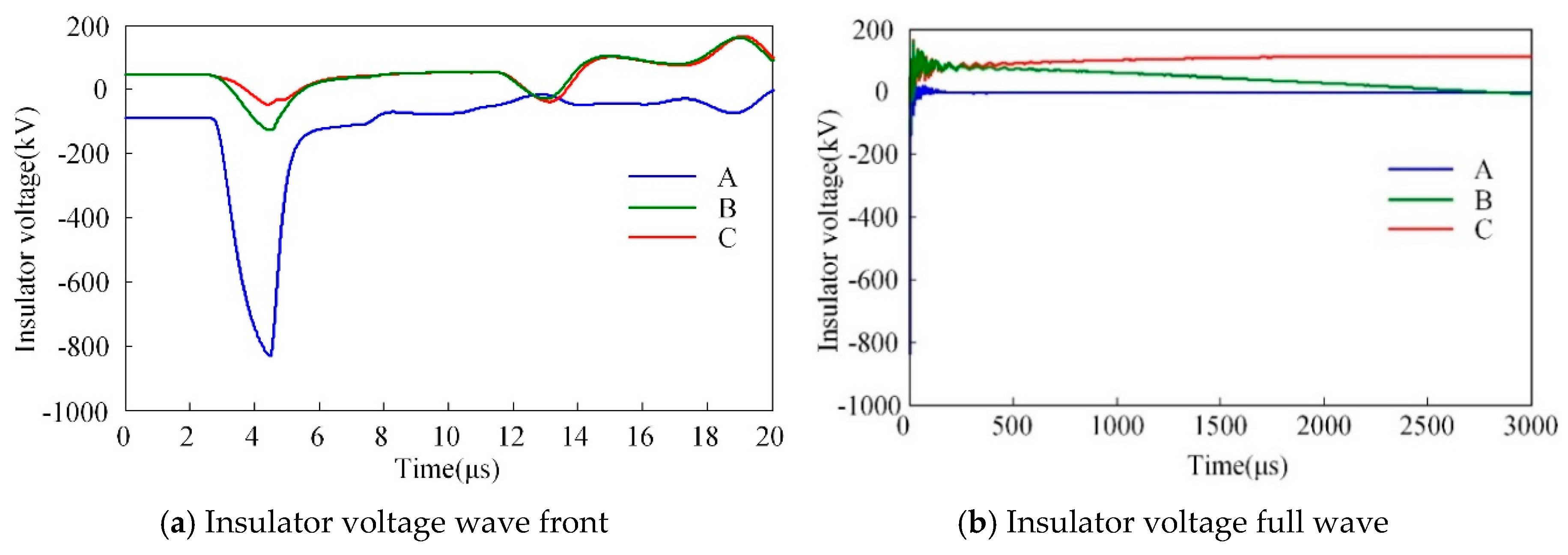
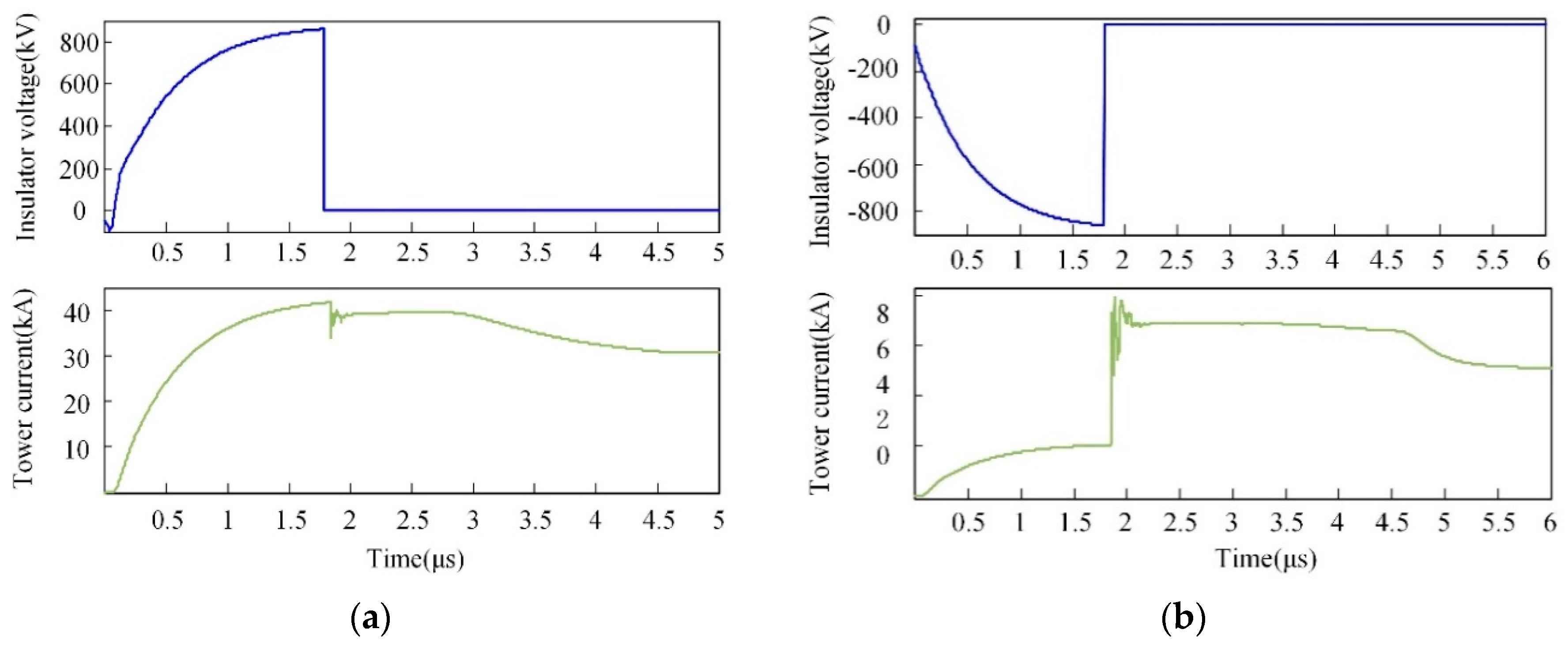

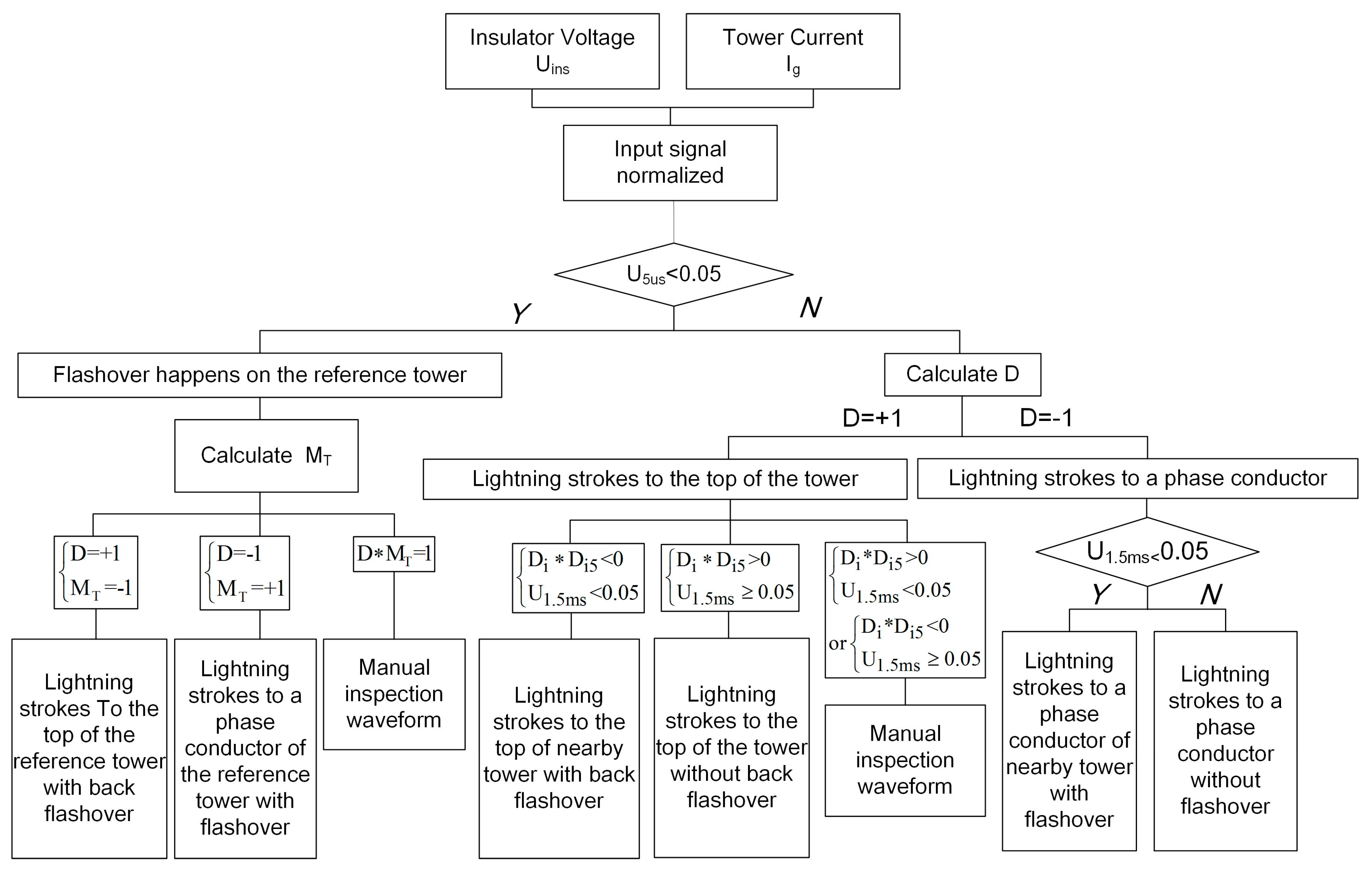
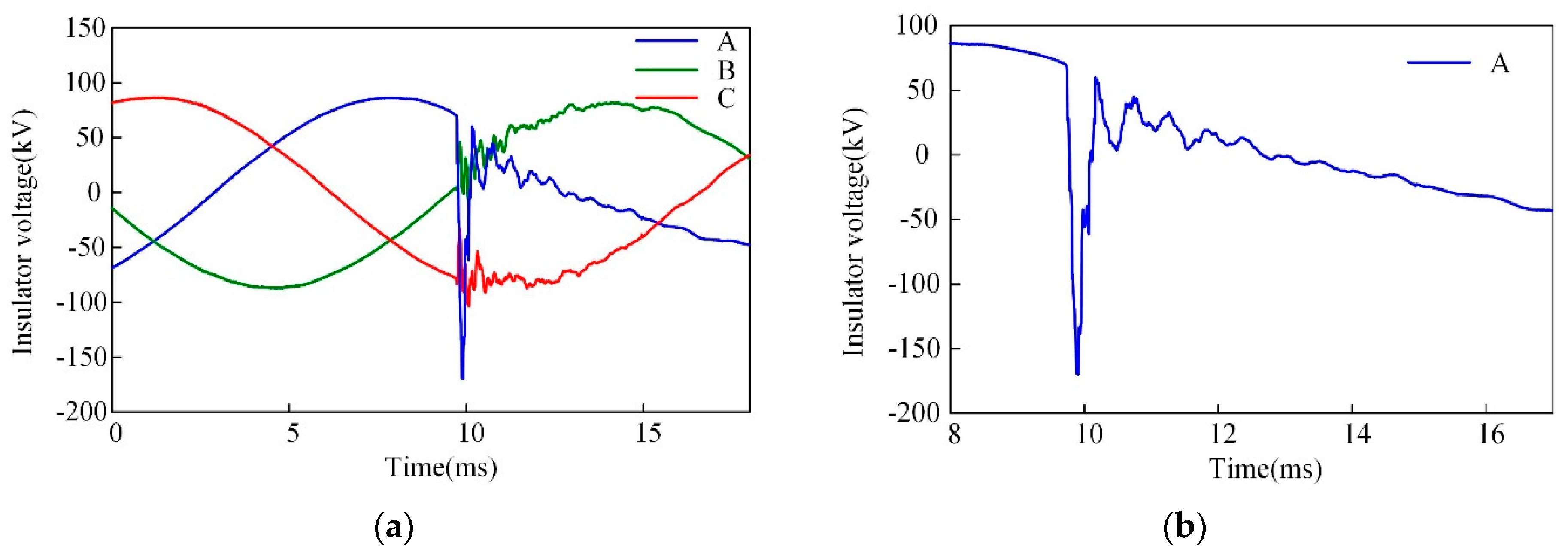
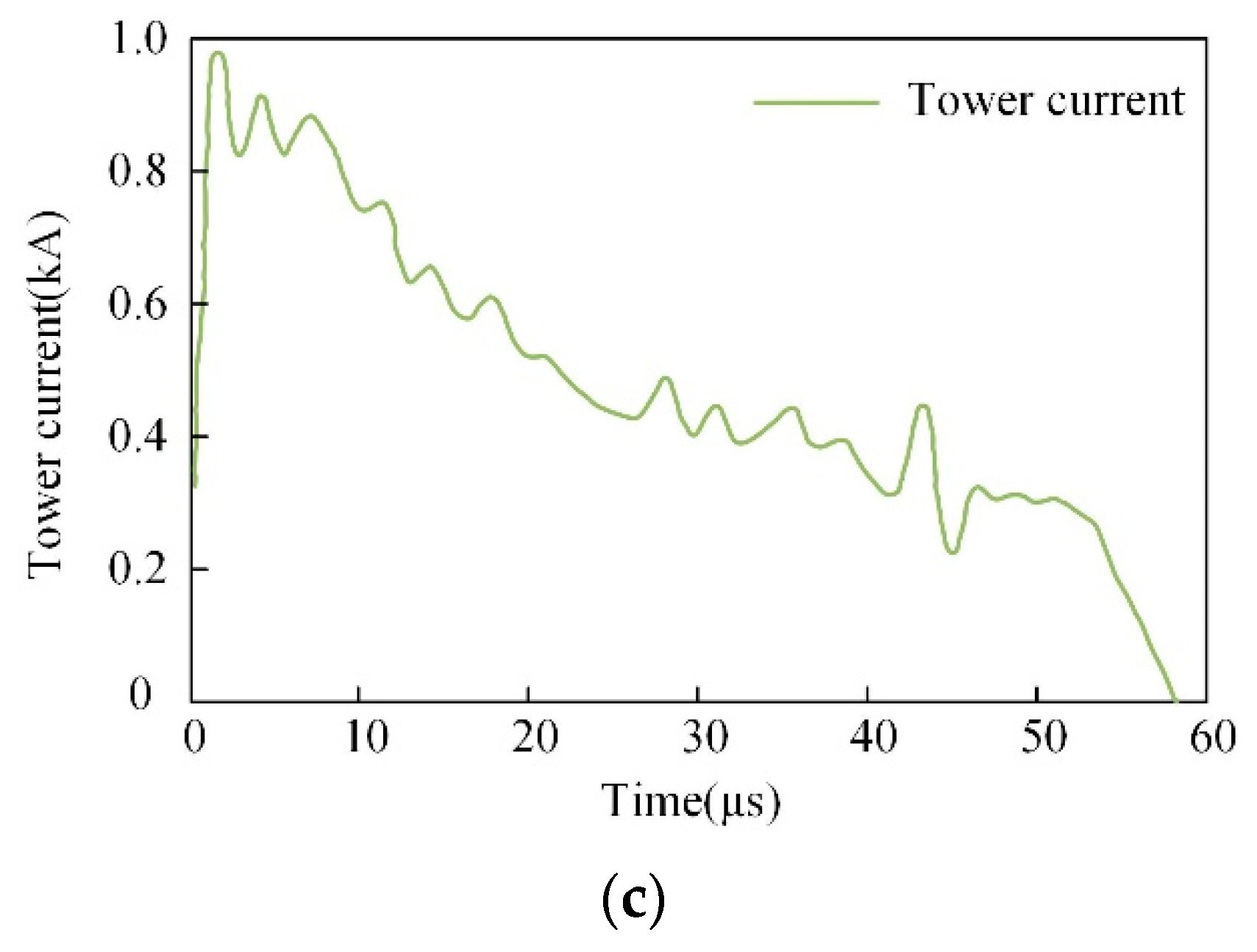
| Lightning Stroke Type | Di | Dt | D = Di·Dt |
|---|---|---|---|
| Negative lightning strokes to the top of the tower | +1 | +1 | +1 |
| Negative lightning strokes to a phase conductor | −1 | +1 | −1 |
| Positive lightning strokes to the top of the tower | −1 | −1 | +1 |
| Positive lightning strokes to a phase conductor | +1 | −1 | −1 |
| Lightning Current Polarity | Lightning Type | PT | Dt | MT = PT·Dt |
|---|---|---|---|---|
| Negative | Back flashover at the reference tower | −1 | +1 | −1 |
| Shielding failure at the reference tower | +1 | +1 | +1 | |
| Positive | Back flashover at the reference tower | +1 | −1 | −1 |
| Shielding failure at the reference tower | −1 | −1 | +1 |
| Fault Type | Position | D | Di·Di5 | U5us | U1.5ms | MT | Identification Results |
|---|---|---|---|---|---|---|---|
| 2.6/50us Lightning strokes to the top of the tower with back flashover | 0 m | +1 | <0 | 0 | 0 | −1 | Lightning strokes to the top of the reference tower with back flashover |
| 700 m | +1 | <0 | 1.177 | 0.002 | / | Lightning strokes to the top of nearby tower with back flashover | |
| 1050 m | +1 | <0 | 1.271 | 0.003 | / | ||
| 2.6/50us lightning strokes to the top of the tower without back flashover | 0 m | +1 | >0 | 0.935 | 0.224 | / | Lightning strokes to the top of the tower without back flashover |
| 700 m | +1 | >0 | 0.769 | 0.225 | / | ||
| 2.6/50us Lightning strokes to a phase conductor with flashover | 0 m | −1 | >0 | 0 | 0 | +1 | Lightning strokes to a phase conductor of the reference tower with flashover |
| 700 m | −1 | >0 | 0.342 | 0.037 | / | Lightning strokes to a phase conductor of nearby tower with flashover | |
| 1050 m | −1 | >0 | 0.816 | 0.044 | / | ||
| 2.6/50us Lightning strokes to a phase conductor without flashover | 0 m | −1 | >0 | 0.633 | 0.234 | / | Lightning strokes to a phase conductor without flashover |
| 700 m | −1 | >0 | 0.606 | 0.225 | / | ||
| 1.2/50us Lightning strokes to the top of the tower with back flashover | 0 m | +1 | <0 | 0 | 0 | −1 | Lightning strokes to the top of the reference tower with back flashover |
| 700 m | +1 | <0 | 1.213 | 0.002 | / | Lightning strokes to the top of nearby tower with back flashover | |
| 1.2/50us Lightning strokes to a phase conductor with flashover | 0 m | −1 | >0 | 0 | 0 | +1 | Lightning strokes to a phase conductor of the reference tower with flashover |
| 700 m | −1 | >0 | 0.298 | 0.031 | / | Lightning strokes to a phase conductor of nearby tower with flashover |
| D | Di·Di5 | U5us | U1.5ms | MT |
|---|---|---|---|---|
| −1 | >0 | 0.612 | 0.211 | / |
| Time | Longitude | Latitude | I (kA) | Number of Towers |
|---|---|---|---|---|
| 02:37:25 | 106:41:30 | 30:33:21 | −5.6 kA | 13, 14 |
© 2019 by the authors. Licensee MDPI, Basel, Switzerland. This article is an open access article distributed under the terms and conditions of the Creative Commons Attribution (CC BY) license (http://creativecommons.org/licenses/by/4.0/).
Share and Cite
Jiang, K.; Du, L.; Chen, H.; Yang, F.; Wang, Y. Non-Contact Measurement and Polarity Discrimination-Based Identification Method for Direct Lightning Strokes. Energies 2019, 12, 263. https://doi.org/10.3390/en12020263
Jiang K, Du L, Chen H, Yang F, Wang Y. Non-Contact Measurement and Polarity Discrimination-Based Identification Method for Direct Lightning Strokes. Energies. 2019; 12(2):263. https://doi.org/10.3390/en12020263
Chicago/Turabian StyleJiang, Kaihua, Lin Du, Huan Chen, Feng Yang, and Yubo Wang. 2019. "Non-Contact Measurement and Polarity Discrimination-Based Identification Method for Direct Lightning Strokes" Energies 12, no. 2: 263. https://doi.org/10.3390/en12020263





